The sacred city of Anuradhapura is a place I really loved visiting during my trip to Sri Lanka. It is part of the famous Sri Lankan Cultural Triangle which is the historic center of the island. The triangle covers the area from Anuradhapura to Polonnaruwa and Kandy.

Anuradhapura is, therefore, one of the pillars of Sri Lankan culture; it’s called the sacred city for a reason! From India, Buddhism came to Anuradhapura and began to spread around the island. Its spread was made possible thanks to the famous encounter between an Indian Buddhist monk (Mahinda) and the king of Anuradhapura, in Mihintale in the 3rd century BC. I’ll tell you more about it at the end of this blog post.
Anuradhapura has been the capital of Ceylon, former name of the country of Sri Lanka, for over a millennium! But it was continually attacked by its Indian neighbors and was eventually invaded and partly destroyed. It was abandoned in 993 and Polonnaruwa became the capital of the country.
The history of Anuradhapura is really rich and we will look at a few aspects of it through the beautiful temples of the city. By the way, the historic site of the city has been a UNESCO World Heritage Site since 1982.
As usual, here are some tips as far as transportation and accommodation are concerned. We can then start our tour of the city!
How To Get To Anuradhapura?
From Dambulla
I made the trip from the city of Dambulla on a motorcycle. It was a 70 km drive so about a 90-minute trip to get to Anuradhapura. If you’re also going there from Dambulla, you should know that there is no train that makes the trip from there to Anuradhapura. You’ll have to take a local bus from Dambulla for a two-hour trip to Anuradhapura. Buses are scheduled every hour.
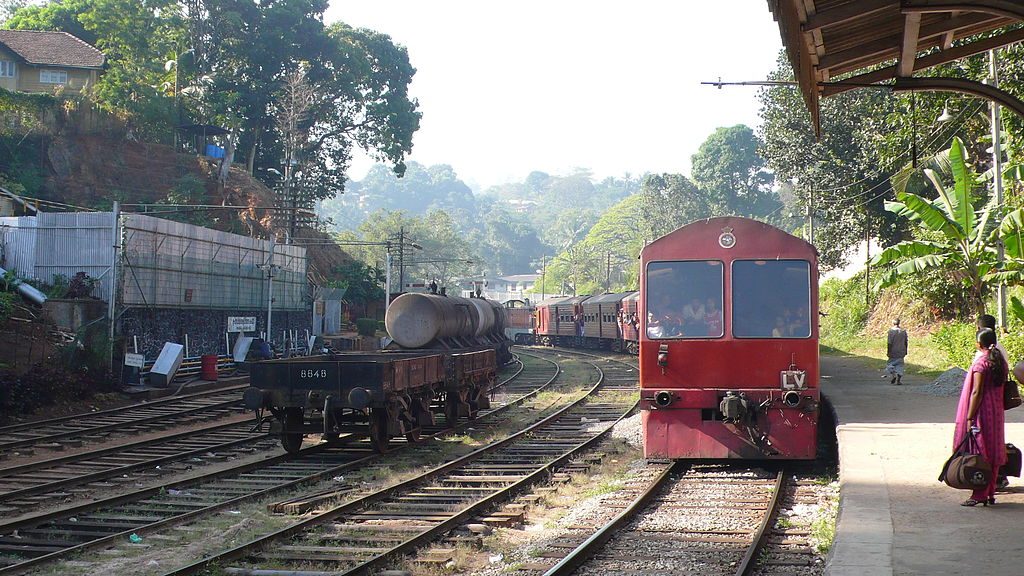
From Colombo
If you’re coming from the capital Colombo, you can take the train to Anuradhapura from Colombo Fort. The trip takes about 4 hours and tickets costs 240 rupees (~ $1.5) for 3rd class and 370 rupees (~ $2) for 2nd class. Train transportation is not expensive in Sri Lanka so if you can get yourself the best available class for more comfort, don’t hesitate to do so! To check out train schedules, have a look at the country’s official railway website which is available in English.
Where To Stay In Anuradhapura?
All historical sites are located next to the city so it would be ideal if you could book your accommodation downtown or in the surrounding area. For your information, the city of Anuradhapura actually has just about 50,000 inhabitants and you will love its peaceful and pleasant atmosphere.
If you’re on a budget, you can book your spot at the Amsterdam Tourist Rest which is a charming guesthouse with a great location where you will find everything you need. You can also rent bikes if you’re planning to go on a temple tour. I think rent prices range from 300 to 400 rupees a day (a little over $2) if I remember correctly.

If you could use a little more comfort and a swimming pool (who wouldn’t?), you can book at the Heladiv Hotel.

Prices are affordable and you simply get what you pay for. Rooms are spacious and if you’re looking for a mix of well-being and adventure, you won’t be disappointed.

Where To Eat In Anuradhapura?
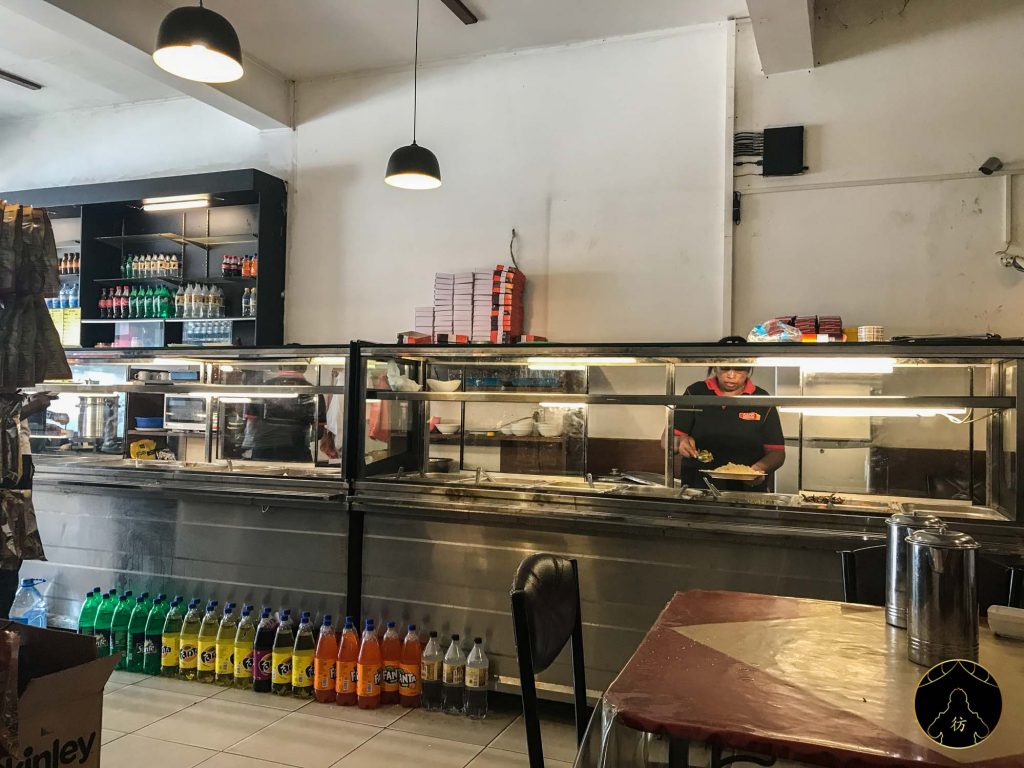
If you want to try the local specialties including the delicious Sri Lankan curry, I recommend the Rangiri restaurant, which is right here. The waiters speak a little English but sign language will easily get you your order. 😉 FYI, a dish typically costs between 300 and 500 rupees (around $2 to 3$).
The 11 Best Things To Do In Anuradhapura
Practical advice aside, let’s start our tour of Anuradhapura and discover the must-see attractions of the city. I marked them on the map below and we will go through them one by one, starting from the south and going up north. To fully enjoy the city, I’d say devote at least a day for Anuradhapura plus half a day for Mihintale (see the end of the blog post).
- Vessagiriya
- Isurumuni Viharaya
- Mirisavatiya Dagoba
- Sri Maha Bodhi (The Sacred Tree
- Ruwanwelisaya
- Jethavana
- Thuparamaya
- Lankaramya Dagoba
- Moonstone
- Abhayagiriya Dagoba
- The Samadhi Bouddha Statue
Most of the historical sites require proper attire that covers at least your knees. If you want to wear shorts, you will have to rent a sarong at each temple or simply buy one once and for all. I recommend you buy one so you can use it everywhere you need to in Sri Lanka and keep it as a nice and convenient souvenir!
As for transportation, I strongly recommend you rent a bike to move around freely because attractions are sometimes a bit far from each other. You can also ask a tuk-tuk to drive you around the city all day.
Get Your Entry Ticket

I am writing an entire blog post on the paid entry to the site because it is a bit complicated and I had trouble understanding it myself at first. You can also be exposed to scammers who take advantage of the confusion around this issue so let’s clear things up a bit here.
To access the temples of the sacred city, you have to pay a $25 entrance fee that will be valid all day, and that you can buy at the archaeological museum. Since the sacred city is not a well-defined area (unlike in Polonnaruwa where the historic site is), there is no actual entrance where people check that you have your ticket. Ticket checks are therefore more random and often take place on the road when you’re riding your bike for example. I was only stopped once by the moonstone for a ticket check, so even if that doesn’t happen systematically, make sure to buy your ticket.
The collected funds are used to preserve the historic site so there’s actually a good reason behind this. Remember that the only place where you will have to pay an additional entrance fee is the Isurumuni Viharaya temple (about 200 rupees).
On the other hand, there is a common scam in Anuradhapura that involves paying $25 directly to your tuk-tuk driver. Although they will tell you that they’re going to buy your ticket with that money, they will actually keep it for themselves and will try to take you to the site by dodging ticket checks or attempting to bribe control agents. So be careful and ask to see your ticket to be sure your money goes to the maintenance of the site.
Without further ado, let’s start our tour of the city! 🙂
1. Vessagiriya
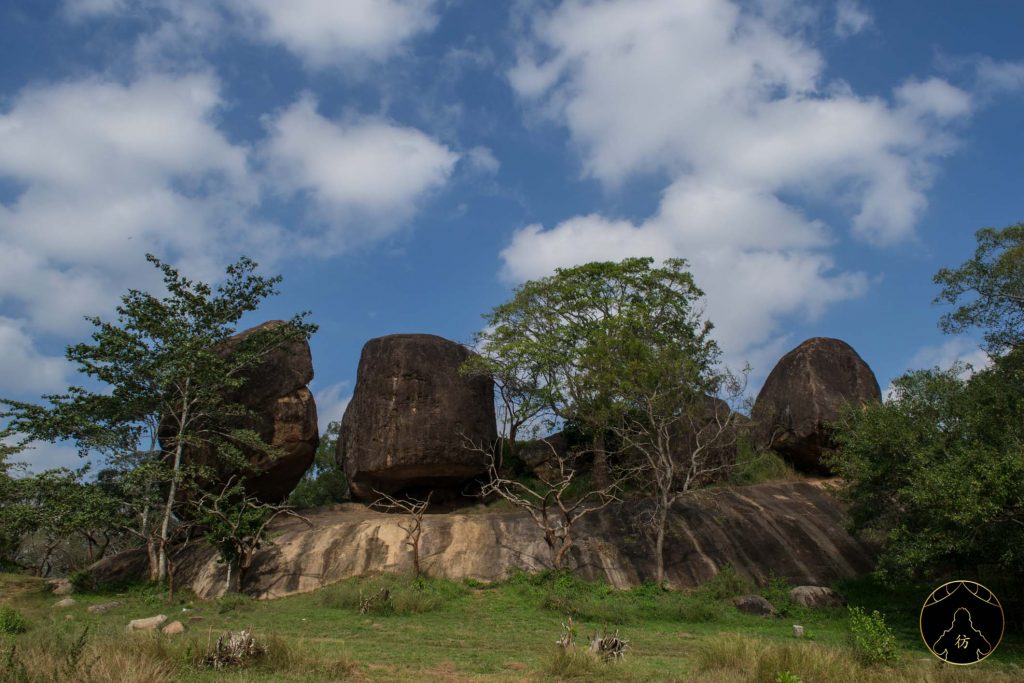
Vessagiriya is an ancient Buddhist monastery that was built in the 3rd century BC. All that is left of it today are huge rocks that used to form the cellars where monks meditated. Although there is not much to see, climbing these huge rocks in this beautiful setting was a really nice adventure.

While strolling around the site, I witnessed a magical show! I actually saw a peacock trying to attract females by exhibiting his sublime feathers. And it worked! 15 minutes later, a female came up. 🙂 I’m sure you’d come across many peacocks in Sri Lanka. If you do, make sure to stay quiet around them, peacocks are rather fearful animals.

2. The Isurumuni Viharaya Temple
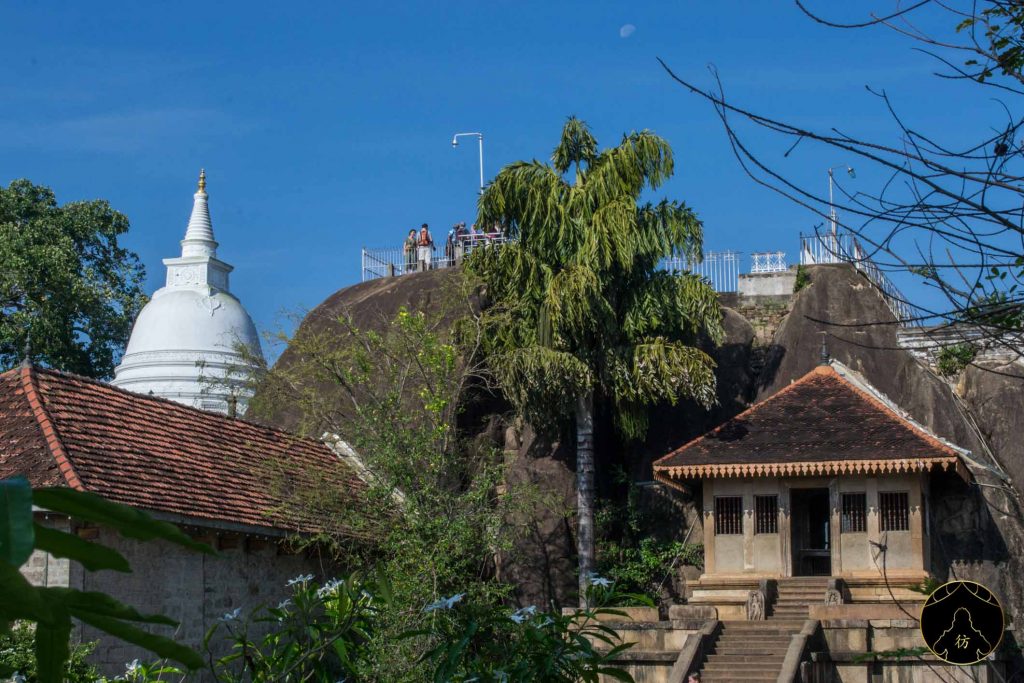
Price: 200 rupees (~ $1), not included in the ticket to the sacred city.
We’re now visiting the Buddhist temple Isurumuni Viharaya. It is known to be home to the Isurumuniya lovers’ sculpture. It portrays a woman sitting on the lap of a man, raising her finger to assert she’s not an easy girl.

The sculpture dates from the 6th century. No one knows exactly who is portrayed here but you’d probably be making a good guess if you thought royalty. During your visit, try throwing a coin into the hole you see below. If it stays in the hole, luck is on its way to you!

I managed to get one in the hole after a few (hundred) attempts! 😀 I’ll let you know when I’m a millionaire. 😉 Anyway, I made lots of new friends in the temple so I can already say that I am wealthy, as far as friendship is concerned. O:)
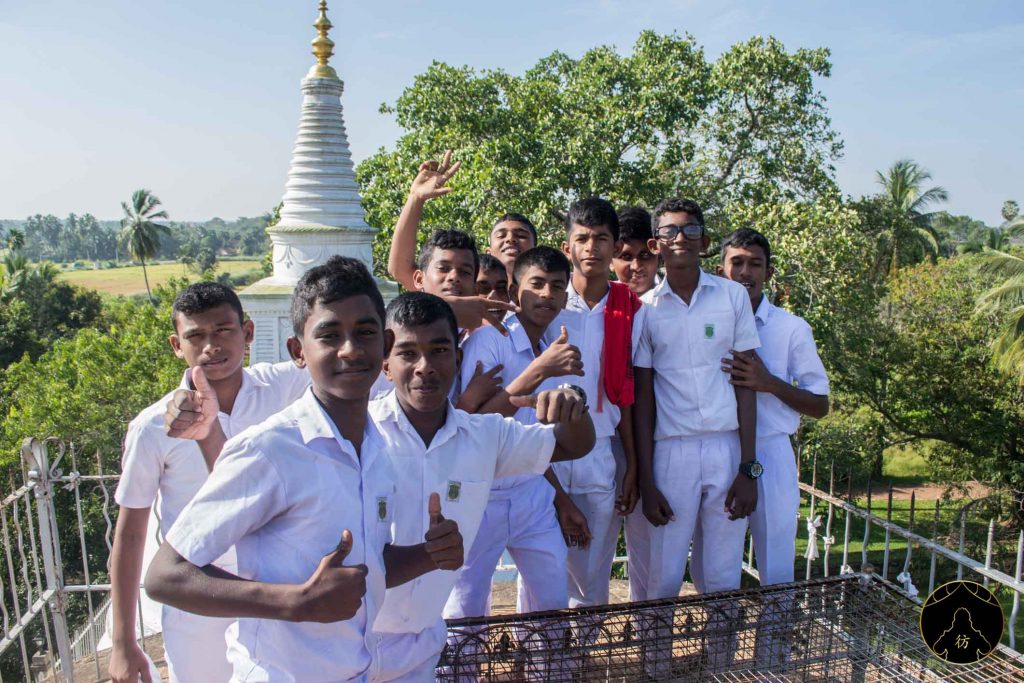
3. Mirisavatiya Dagoba
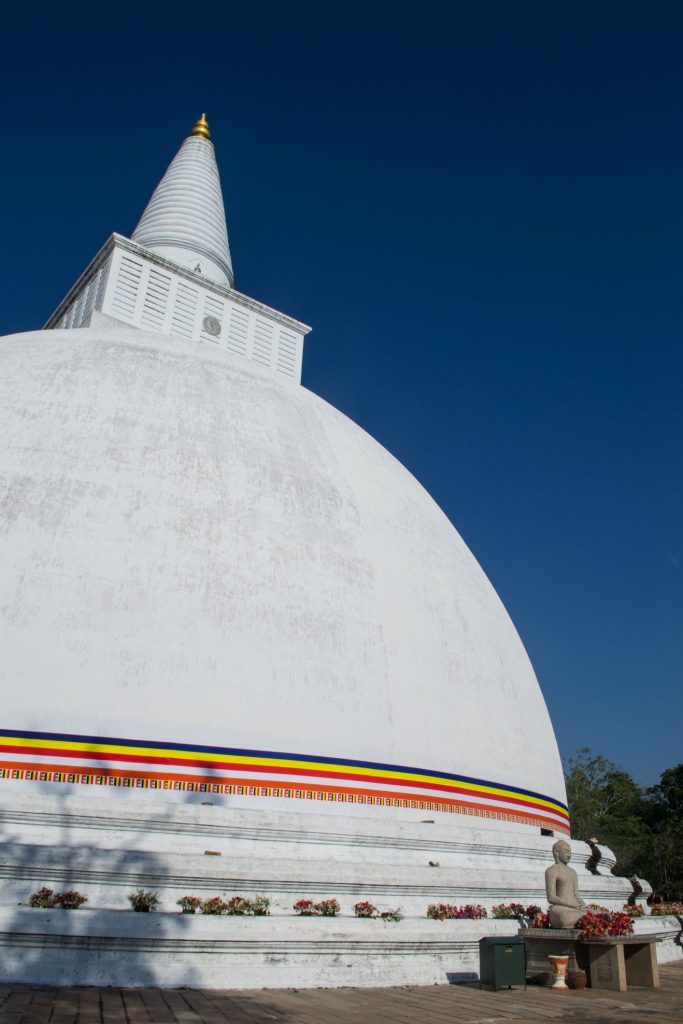
Let’s move on to more serious stuff with the beautiful Mirisavatiya Dagoba. FYI, the term “dagoba” is the equivalent of “stupa” in Sri Lanka. This one was built by King Dutugamunu in the 2nd century BC. It is said that before bathing in the Tissa Wewa, he laid down his scepter (which contained a relic of Buddha) on the shores of the artificial reservoir.
When he came back, he couldn’t move the scepter, which was somehow anchored to the ground. The king saw a sign in that and built the Mirisavatiya dagoba at that very spot.
4. Sri Maha Bodhi (The Sacred Tree)
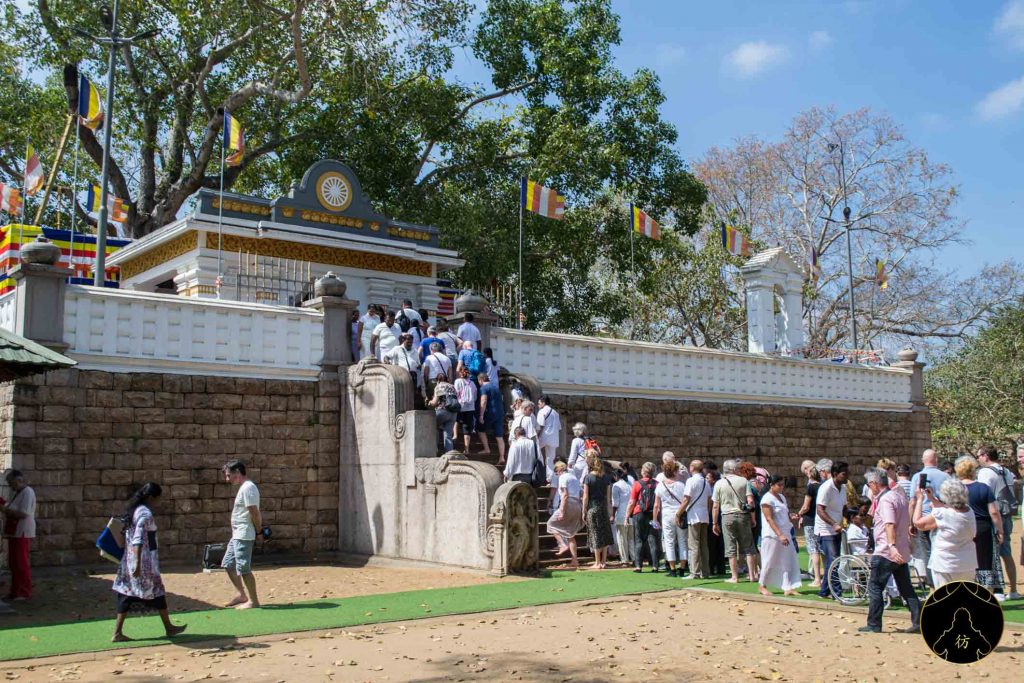
The sacred Sri Maha Bodhi tree is one of the most popular attractions in Anuradhapura and people often stand in line there, bringing offerings. What is so special about this tree, you say? You may know that Prince Siddhartha Gautama tried several methods to reach enlightenment. It was only after meditating under a fig tree that he became Buddha, the awakened one.
It is said that Sri Maha Bodhi grew thanks to a cutting of the same fig tree brought back from India by the daughter of Emperor Ashoka, the Princess Sangamitta. I think you can understand why this place is so important to the local people. Many people come to recite mantras together all day long. It was a very exciting atmosphere and I spent a good half hour there, enjoying the great vibes.
5. Ruwanwelisaya

The Ruwanwelisaya stupa is also one of the busiest places in the holy city. The crowd you see in the pictures is a Sunday crowd by the way. Some recommend to avoid weekends to visit the stupa but I’d say the opposite. Because then you can watch Sri Lankans going about their daily lives and performing their actual habits and traditions.
What you see on the left in the picture below are just water vapor jets to freshen up the visitors. It feels good when it is 32 degrees outside! 🙂
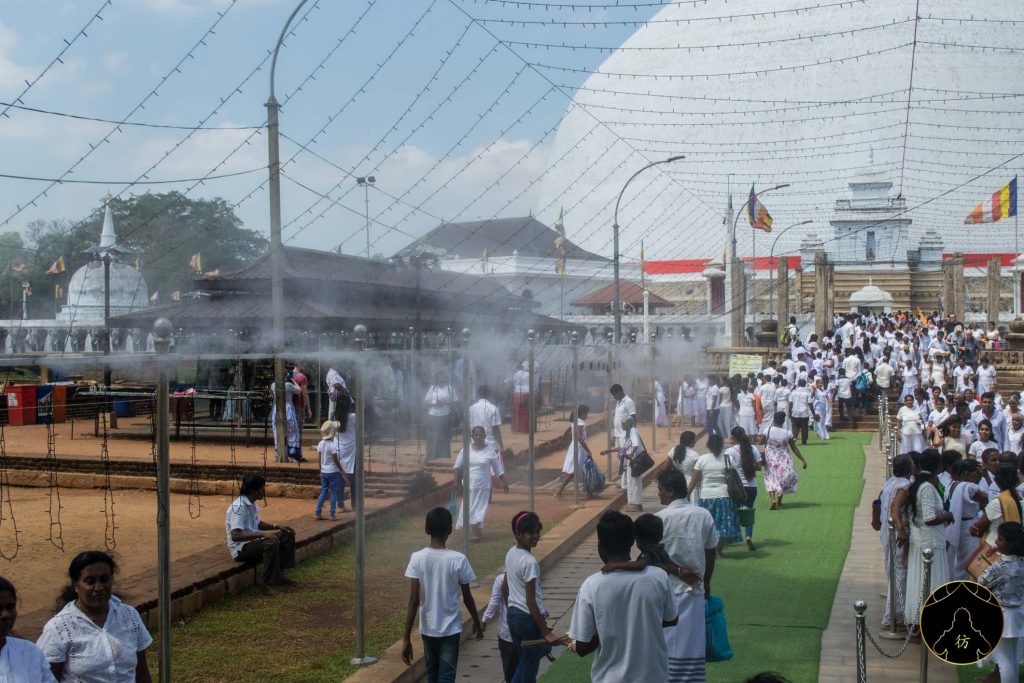
The Ruwanwelisaya stupa is said to contain relics of Buddha and is one of the greatest religious monuments in the world! It is 103 meters high and about 290 meters in circumference. It does make you feel really small.
If you like, you can do like the locals and drop some lotus flowers as an offering at the entrance of the stupa, then go around it clockwise.
6. Jethavana

This is another magnificent monument in Anuradhapura. It’s the Jethavana stupa which stands out by the beautiful ocher color of its bricks. Very few people visit this site so make sure to visit it! The stupa was built in the 3rd century BC and is said to contain a piece of the Buddha Belt. Yes! It’s considered a relic. 🙂
The size of the stupa is also impressive, it’s 122 meters high! It’s built with a little less than 100 million bricks that have been assembled on this very site. At the time, building that stupa was a real technical accomplishment.

7. Thuparamaya

Thuparamaya is a Buddhist temple that I also recommend you visit during your stay in Anuradhapura. The most interesting part of this archaeological site is probably the ruined building that you will find on your left when you get to the temple. The roof and most of the walls have collapsed, but a door there has stood the test of time, framing the Buddha statue inside the temple.
As you can see, it’s like we’re going back in time, visiting all these historic sites so it was a truly magical and exotic experience.
8. Lankaramya Dagoba
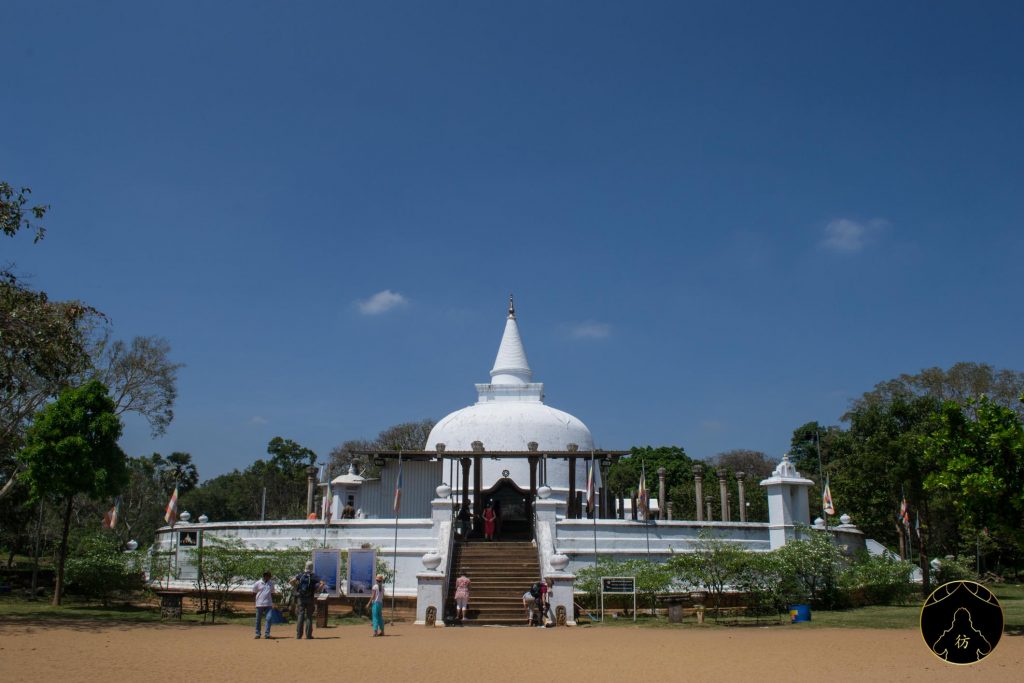
Lankaramya Dagoba The Lankaramya dagoba was built by King Valagamba in the first century BC. Seeing the pillars around the building, one can imagine the structure that used to cover the stupa but that no longer exists today.
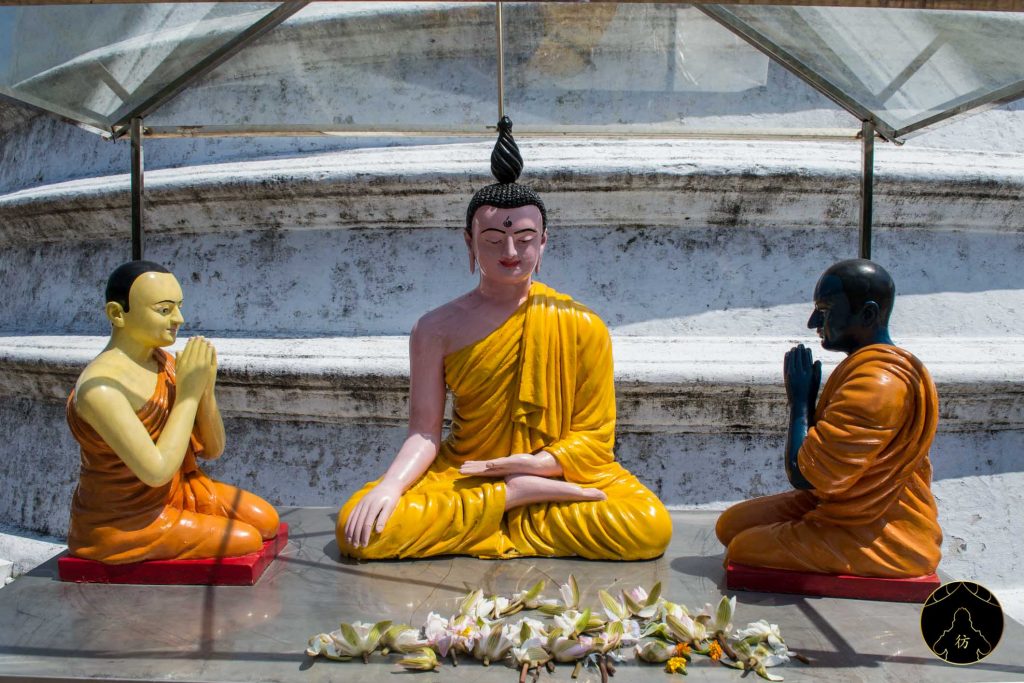
9. Mahasena Temple (Moonstone)
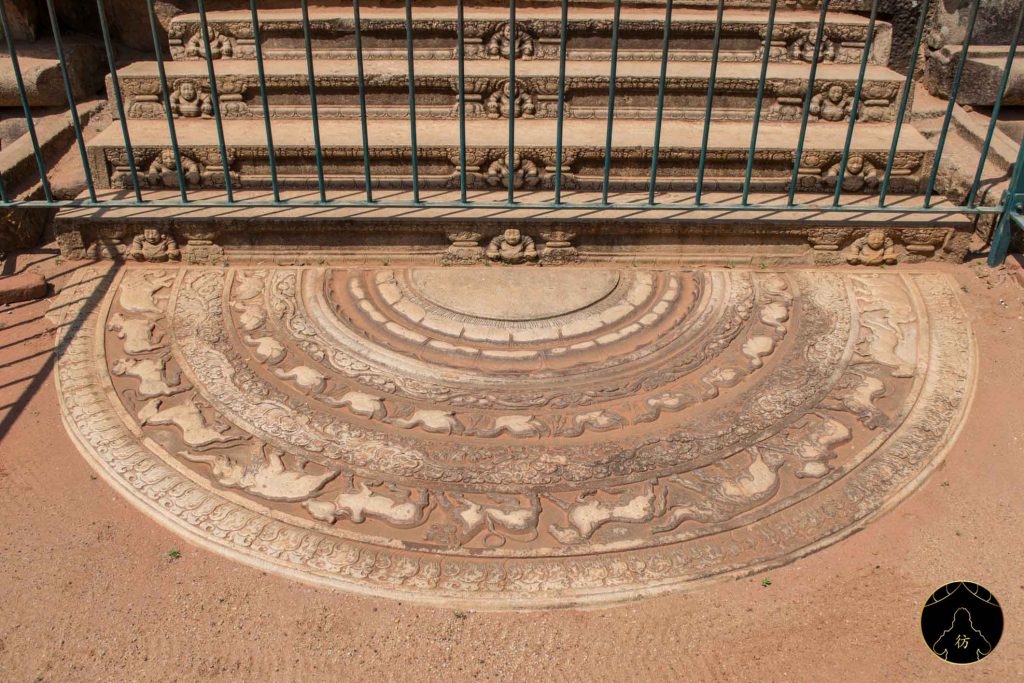
Mahasena (moonstone in English or sandakada pahana in Sri Lankan) is an architectural element that is very common in Sri Lanka. It is found at the entrance of temples but also at ordinary houses or hotels. First seen during the Anuradhapura period, the moonstone that you see above dates precisely from that period.
The design of the moonstones is always the same. From the center out, you can see:
- Half a lotus,
- Intertwined leaves,
- Swans,
- Elephants, as symbols of growth, lions as symbols of energy, horses as symbols of power and bulls as symbols of patience
- Flames
10. Abhayagiriya Dagoba
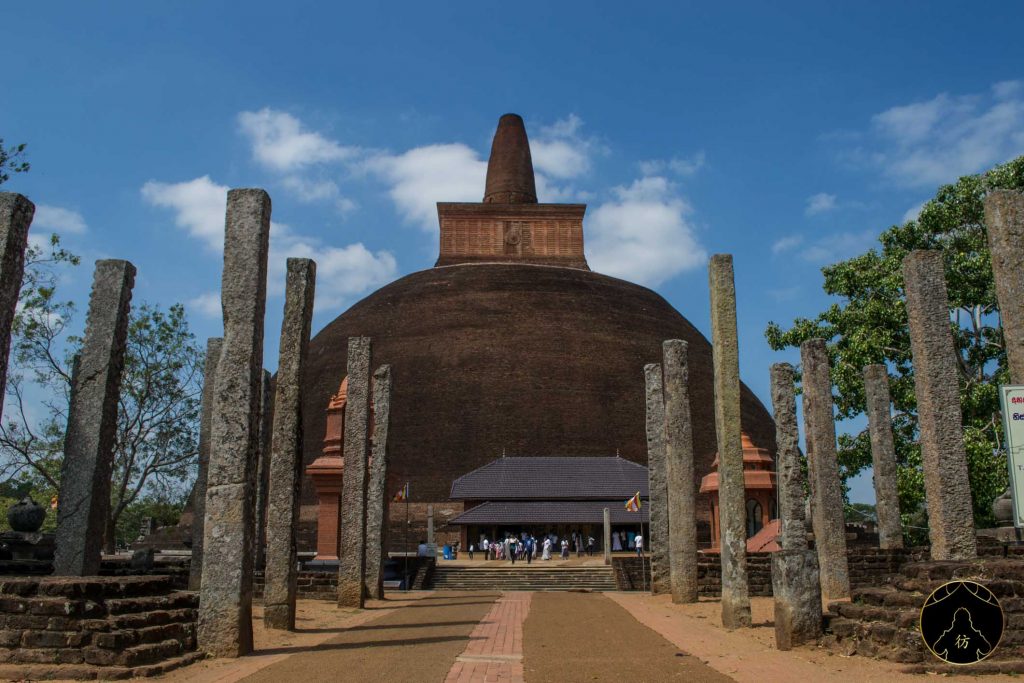
The Abhayagiriya dagoba is part of the famous monastery of the same name where thousands of Buddhist monks used to gather. Around the 13th century, however, the monastery was no longer active. It is actually the Abhayagiriya dagoba that you can see printed on the ticket to the sacred city. You will notice that it looks almost exactly like the Jethavana dagoba that I showed you earlier except that the tip of this dagoba remains intact.
11. The Samadhi Bouddha Statue
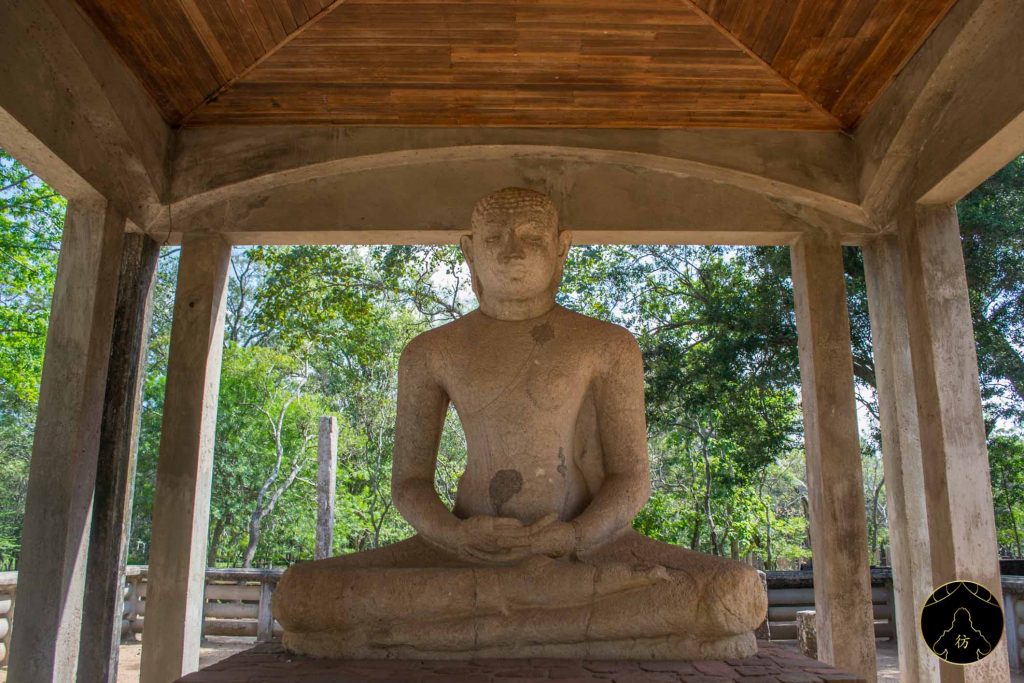
The Samadhi statue is our last attraction on this list. It was built in the 3rd or 4th century. You may notice that it has been restored a few times already, the nose had to be redone too. Don’t forget that if you’d like to take a picture with the Buddha statue, don’t turn your back on it. This is seen as a sign of disrespect and applies everywhere in Sri Lanka.
Visit Mihintale’s Historic Site
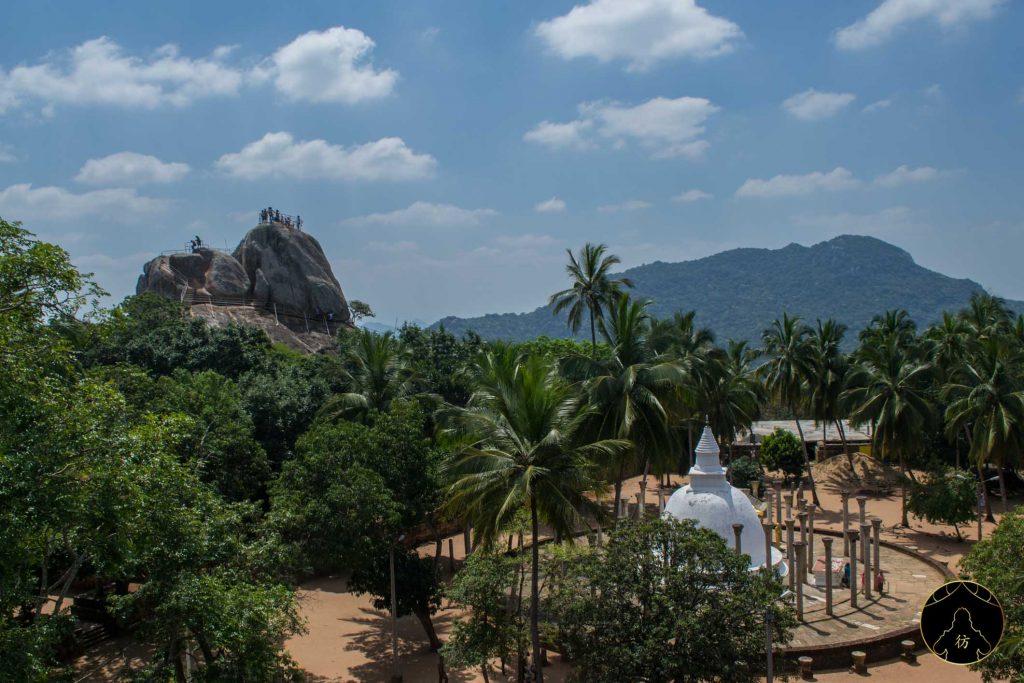
- Price: 500 rupees
- Exact location: https://goo.gl/maps/G3Hta8TCGrt
After visiting the beautiful sacred city of Anuradhapura, I suggest you also visit Mihintale’s historical site. There’s a beautiful historical site there known to be the cradle of Buddhism in Sri Lanka. It is said that an Indian Buddhist monk (Mahinda) came from the sky and landed on the rock that you see in the picture below to meet the king of Anuradhapura.

Mihintale is only 15 kilometers east of Anuradhapura. It would be such a shame to miss out on such a beautiful city! All my tips on how to get there and what to visit on Mihintale Sri Lanka.
Our tour of Anuradhapura ends here! How do you like this city? Are you going to visit it? Let me know in the comments below. 🙂
If you are a culture and history lover, you won’t regret adding Anuradhapura to your itinerary in Sri Lanka.
Don’t miss any of my blog posts on my trips in Asia, subscribe to my social media: Facebook Page, Facebook Group, Instagram, Youtube and Pinterest.
See you soon,
MF


This is a very nice article, thanks for your post!